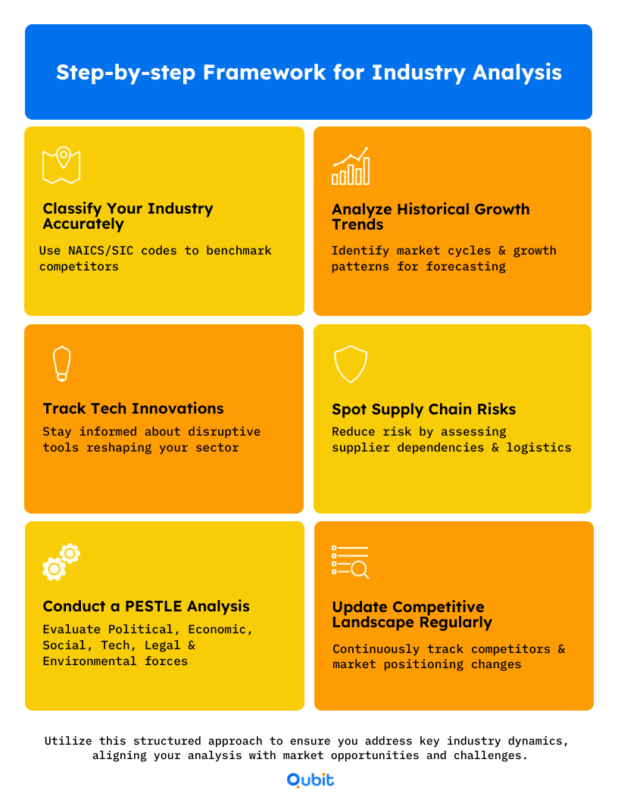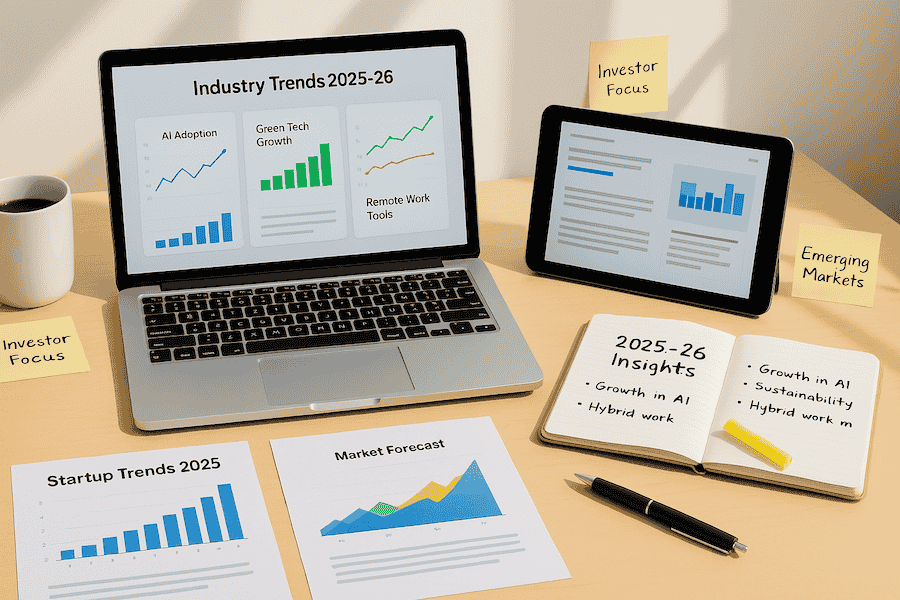The ability to anticipate shifts in industry dynamics can be the difference between thriving and merely surviving in a competitive market. Industry analysis is the cornerstone for identifying emerging opportunities and mitigating risks. By examining trends, businesses can align their strategies with evolving consumer demands and technological advancements.
Accessing the right market research tools is key to identifying emerging industry trends and gaining valuable insights into market demands. These tools empower startups to conduct thorough analyses, uncovering gaps and opportunities that drive innovation.
This blog explores actionable strategies to stay ahead of the curve, offering a structured framework for industry analysis that supports long-term success.
Global Trends Shaping Startups
Startups are adapting to a world marked by rapid change and growing complexity. Global challenges such as supply chain disruptions and increasing sustainability demands are reshaping how businesses operate. Consumers now expect hyper-personalized, ethical, and environmentally conscious solutions, creating opportunities for startups to innovate in ways that align with these values.
The convergence of technological advancements and green initiatives is driving this transformation. For instance, the global artificial intelligence market is projected to grow at a compound annual growth rate (CAGR) of 30% from 2024 to 2030, with technologies like Generative AI and Autonomous Tech enabling startups to deliver enhanced personalization and predictive capabilities. This shift underscores the importance of conducting a thorough industry analysis to identify emerging opportunities and risks.
Understanding these trends is essential for startups aiming to thrive in a dynamic market. For those seeking actionable insights, exploring the potential of AI Growth can provide valuable direction.
Generative AI & Autonomous Tech: Strategies for Innovation
- Generative AI:
Generative AI is reshaping industries by introducing groundbreaking efficiencies and creative possibilities. This powerful tool for content creation and prototyping accelerates innovation by enabling rapid iterations and reducing development cycles, allowing businesses to design digital assets and simulate complex prototypes more effectively. - Autonomous Technologies:
In logistics and manufacturing, autonomous systems transform operations by automating delivery processes, significantly reducing operational costs and improving delivery times. For instance, AI-driven robotics enhance production reliability by minimizing errors and ensuring consistent output—a combination of speed and precision that is critical for meeting growing consumer demands. - Competitive Landscape:
Understanding how competitors adopt these technologies is essential for staying ahead in tech-driven sectors. Analyzing market shifts and emerging trends enables businesses to align their strategies accordingly and anticipate potential disruptions. - Future Integration:
As generative AI and autonomous solutions continue to evolve, their integration into creative processes, logistics, and manufacturing will redefine operational standards. Businesses that embrace these innovations will drive efficiency and secure a competitive edge in rapidly changing markets.
Understanding how competitors adopt these technologies is essential for staying ahead in tech-driven sectors. Analyzing the competitive landscape allows businesses to anticipate market shifts and align their strategies with emerging trends.
Decentralized Finance & Fintech Innovations: Unlocking Modern Finance
Decentralized finance (DeFi) and fintech are transforming the financial landscape by offering innovative alternatives to traditional systems:
- Democratizing Modern Finance:
Together, DeFi and fintech democratize access to credit and empower individuals and businesses with tools once exclusive to traditional institutions, unlocking a new era of modern finance. - DeFi Transformation:
Powered by blockchain, DeFi enables peer-to-peer transactions that bypass intermediaries, ensuring greater transparency and liquidity. With a projected CAGR of 11% from 2024 to 2029, blockchain-based financial solutions are rapidly expanding. - Blockchain-Based Lending:
By eliminating middlemen, blockchain-based lending streamlines loan processes, making them faster and more efficient. This model reduces costs for borrowers and enhances credit access, while providing lenders with improved security and transparency. - Embedded Finance Models:
Solutions like Buy Now Pay Later (BNPL) integrate financial services directly into non-financial platforms, creating seamless, frictionless transactions that revolutionize customer experiences. - Personalized Fintech Innovations:
Fintech is driving the creation of personalized financial products tailored to diverse consumer needs. Through effective customer segmentation, businesses develop user-centric solutions that adapt to evolving industry trends.
Fintech innovations are also driving personalized financial products, tailored to meet diverse consumer needs. Businesses can use customer segmentation strategies to develop user-centric solutions that adapt to evolving industry trends.
Optimizing Logistics & Manufacturing: Embracing Smart Innovation
Transforming logistics and manufacturing processes is essential for staying competitive in a dynamic market. Consider these key points:
- Adopting Cutting-Edge Technologies:
Implementing smart manufacturing powered by IoT and AI makes production systems more agile and data-driven, enabling businesses to quickly respond to market demands. - Predictive Inventory Management:
By analyzing historical data and forecasting trends, companies can prevent stockouts and avoid excess inventory—streamlining operations, optimizing capital use, and reducing waste in line with sustainability goals. - Real-Time Tracking:
Enhances supply chain transparency, fosters consumer trust through verified ethical sourcing, and ensures compliance with material origins. - Fundraising Strategies and Supply Chain Insights:
Incorporating supply chain research into fundraising strategies can differentiate startup pitches, showcasing unique operational insights to potential investors.
Smart innovation in logistics and manufacturing is no longer optional—it’s vital for efficiency and market competitiveness.
Additionally, using research in fundraising strategies can help startups showcase how supply chain insights differentiate their pitch to investors.
Personalized Consumer Experiences: Data-Driven Offering Strategies
Tailored consumer experiences are no longer a luxury—they’re an expectation. By harnessing the power of AI and data analytics, businesses can deliver hyper-personalized offerings that resonate with individual customer preferences. Predictive algorithms play a pivotal role in this transformation, enabling companies to anticipate market trends and adjust their inventory dynamically. This ensures that products are available just when customers need them, reducing waste and optimizing operational efficiency.
Centralized consumer data further enhances personalization by allowing real-time adjustments to marketing strategies. For example, dynamic pricing models can adapt to current demand, offering customers competitive rates while maximizing revenue. Additionally, targeted marketing campaigns based on behavioral insights foster stronger customer loyalty, as they address specific needs and preferences.
By embracing these data-driven strategies, businesses not only enhance customer satisfaction but also unlock sustainable growth opportunities in an increasingly competitive marketplace.
Sustainable Innovations: Climate Tech & Green Consumer Goods
The startup ecosystem is witnessing a transformative shift as sustainability becomes a cornerstone of innovation. Green technology startups are pioneering solutions that integrate renewable energy and eco-friendly processes, addressing urgent climate challenges. From solar-powered systems to advanced energy storage, these ventures are scaling their impact while reducing environmental footprints.
In parallel, the consumer goods industry is embracing circular economy principles, rethinking product design and waste management. By prioritizing reuse, recycling, and sustainable sourcing, brands are not only cutting down on waste but also fostering trust among eco-conscious consumers. These practices are reshaping industries, proving that profitability and sustainability can coexist.
As the demand for green solutions grows, startups and established companies alike are redefining their strategies to align with a more sustainable future. This evolution highlights the critical role of innovation in combating global climate issues.
Industry-Specific SaaS Solutions: Customization for Competitive Growth
Tailored software solutions are transforming how industries address their unique operational challenges. Vertical SaaS platforms, designed specifically for niche markets, offer businesses the ability to streamline processes, improve user satisfaction, and meet industry-specific compliance requirements. By focusing on the distinct needs of a sector, these solutions ensure higher adoption rates and foster long-term customer retention.
Customization plays a pivotal role in creating a competitive edge. Features tailored to specific workflows not only enhance efficiency but also act as a significant barrier for competitors entering the market. This differentiation is particularly valuable in saturated industries, where standing out can directly impact growth. Moreover, understanding how vertical SaaS insights can improve a startup’s investment appeal complements broader strategies like finding investors for startups, as it highlights the importance of market readiness and strategic positioning.
By addressing industry-specific pain points, vertical SaaS solutions empower businesses to thrive in their respective markets, driving sustainable growth and innovation.
New Applications of Web3: Embracing Decentralized Innovation
Web3 technologies are reshaping the digital landscape and extending their influence far beyond finance. Here’s a summary of key points:
- Empowering a User-Centric Future:
As Web3 continues to evolve, it fosters decentralized innovation and moves toward a more equitable digital ecosystem. - Decentralized Platforms:
Unlock opportunities in digital identity, social networking, real estate, and gaming by prioritizing user control and new monetization models. - Digital Identity Solutions:
Empower users to securely manage personal information without relying on centralized authorities. - Decentralized Social Networks:
Offer alternatives to traditional platforms with greater transparency and enhanced user autonomy. - NFT-Based Programs:
Disrupt loyalty schemes and redefine value exchange through tokenized assets, from exclusive memberships to tokenized real estate. - Gaming Transformation:
Enable players to truly own and freely trade in-game assets through blockchain-based platforms.
Modern Workforce Trends: Shaping Hybrid Work and Talent Platforms
The post-pandemic workforce has evolved significantly, with companies embracing innovative approaches to enhance both operations and employee satisfaction:
- Scalable Solutions:
As businesses adapt, the focus is on creating systems that balance operational efficiency with employee satisfaction for long-term growth. - Hybrid Work Technologies:
Enable seamless communication and collaboration across remote and in-office teams, ensuring a unified company culture. - Gig-Based Talent Marketplaces:
Provide access to specialized skills through fractional employment models, allowing startups and small businesses to scale efficiently without committing to full-time hires. - Employee Wellness Tools:
Invest in mental health resources, flexible schedules, and productivity-enhancing platforms to foster a healthier, more engaged workforce.
On-Demand Startup Models: Meeting Instant Consumer Needs
The demand for speed and convenience is reshaping industries, with on-demand startups leading the charge. These innovative models are transforming service delivery across retail, finance, and healthcare by offering solutions tailored to instant consumer needs.
Dark stores are revolutionizing local retail by enabling rapid order fulfillment, ensuring customers receive their purchases in record time. Similarly, instant pay systems are addressing financial liquidity challenges, empowering individuals to access earned wages without delay. In healthcare, telemedicine platforms are bridging the gap between patients and providers, delivering timely consultations and prescriptions with just a few clicks.
These models are not just meeting expectations—they’re setting new standards. By prioritizing efficiency and accessibility, on-demand startups are redefining how essential services are delivered, fostering a culture of immediacy that resonates with modern consumers.
Ethical and Purpose-Driven Startups: Transparency and Social Impact
Building a brand that resonates with value-driven customers requires more than just a great product—it demands a commitment to ethics and purpose. Startups that prioritize ethical labor practices, such as fair wages and safe working conditions, not only foster trust but also strengthen customer loyalty. Certifications like Fair Trade and B Corp provide tangible proof of these commitments, making it easier for consumers to align their purchases with their values.
Transparency in sourcing further sets startups apart in competitive markets. By openly sharing the origins of materials and production processes, companies can cultivate a positive brand image that stands out.
Additionally, startups with clear social good initiatives—whether through environmental sustainability or community support—attract not only conscious consumers but also mission-driven investors. These efforts create a ripple effect, amplifying both impact and profitability while aligning with the growing demand for purpose-driven business models.
A Step-by-Step Framework for Comprehensive Industry Analysis
Understanding your industry is the cornerstone of strategic planning. A thorough industry analysis involves market research techniques like systematically examining market size, growth patterns, and competitive forces to uncover actionable insights. This framework provides startups with a structured approach to refine their strategies and stay ahead.

1. Classify Your Industry Accurately
Begin by identifying the specific industry your business operates in. Use established classification systems like NAICS or SIC codes to ensure precision. This step helps you benchmark against relevant competitors and access accurate market data.
2. Analyze Historical Growth Trends
Reviewing historical data reveals patterns that can guide future decisions. For instance, identifying cyclical trends or periods of rapid expansion provides a clearer picture of market dynamics. This data is invaluable for forecasting and aligning your business goals with industry potential.
3. Monitor Technological Innovations
Technology is a key driver of change. Stay informed about emerging tools, platforms, and processes that are reshaping your industry. By tracking these advancements, startups can identify opportunities for differentiation and innovation.
4. Identify Supply Chain Vulnerabilities
Understanding your supply chain is critical. Assess potential risks, such as reliance on single suppliers or geopolitical issues, to build resilience. A robust supply chain ensures stability and minimizes disruptions.
5. Conduct a PESTLE Analysis
A PESTLE analysis evaluates Political, Economic, Social, Technological, Legal, and Environmental factors influencing your industry. This macroeconomic perspective helps businesses anticipate external challenges and adapt proactively.
6. Update Your Competitive Landscape Regularly
Industries evolve rapidly, making it essential to revisit your analysis periodically. Incorporate expert insights and competitor data to refine your positioning and maintain relevance.
By following these steps, startups can develop a dynamic understanding of their industry and make informed decisions. For assistance in presenting your analysis effectively, explore our Pitch Deck Creation services.
Startup Ecosystem Analysis: Building a Network for Success
A thriving startup ecosystem is built on collaboration, mentorship, and access to essential resources. Engaging with experienced advisors can provide startups with the guidance needed to overcome early challenges and refine their business strategies. Robust support networks, including peer startups and influential founders, foster an environment of shared learning and innovation.
Educational partnerships play a pivotal role in equipping startups with the knowledge and skills required to adapt to evolving market demands. Funding channels, such as venture capital firms and angel investors, offer the financial backing necessary for scaling operations. Additionally, professional services—ranging from legal counsel to marketing expertise—ensure startups can focus on their core objectives without being bogged down by administrative hurdles.
Efficient business infrastructure and HR management further contribute to the ecosystem’s success by streamlining operations and attracting top talent. The inspirational impact of successful founders within the ecosystem cannot be understated; their achievements serve as a benchmark and source of motivation for emerging startups.
A strong startup ecosystem not only accelerates growth but also fosters resilience, enabling businesses to thrive in competitive landscapes.
Global Expansion Strategies: Applying Geographic Market Analysis
Expanding into international markets requires a thoughtful approach to understanding regional dynamics. Startups can adapt traditional market analysis frameworks to evaluate geographic-specific opportunities and challenges. By focusing on factors such as local consumer behavior, regulatory environments, and competitive landscapes, businesses can create tailored strategies for entering new markets.
For instance, applying industry analysis tools like Porter’s Five Forces can reveal how local suppliers, competitors, and customer preferences influence market entry. Similarly, SWOT analysis can be customized to highlight regional strengths, weaknesses, opportunities, and threats. This localized approach ensures that startups are not only identifying potential growth areas but also mitigating risks tied to cultural and economic differences.
Adapting these frameworks empowers startups to make informed decisions, ensuring their global expansion efforts align with the unique characteristics of each target market.
Conclusion
Crafting a solid business plan requires more than just outlining goals—it demands a strategic approach that incorporates industry analysis at every stage. By understanding market trends, identifying competitive advantages, and aligning resources effectively, startups can position themselves for long-term success. Each strategy discussed throughout this blog plays a pivotal role in shaping a plan that not only attracts investors but also ensures sustainable growth.
Integrating industry insights into your planning process is essential to remain adaptive and competitive. This approach allows startups to anticipate challenges, refine their pitch, and secure the funding needed to bring innovative ideas to life.
If you're looking to secure the capital to fuel your innovative ideas, we at Qubit Capital are here to help. Explore our Fundraising Assistance service to elevate your startup. Let us guide you in refining your pitch and achieving your business goals.
Key Takeaways
- Industry analysis combines macro-trend evaluation with actionable business strategies.
- Technological innovations like AI and DeFi are significantly reshaping the startup ecosystem.
- Sustainable and ethical practices are becoming central to modern business models.
- A systematic framework for industry analysis is essential for making informed strategic decisions.
- Leveraging data-driven insights paves the way for successful market expansion and competitive advantage.
Frequently asked Questions
How to do market analysis for a startup?
Start by following a structured industry analysis framework—identify your industry classification, review historical trends, monitor technological advances, and map out your competitive landscape. Utilizing market research tools can provide the data you need to make informed decisions.


 Back
Back



